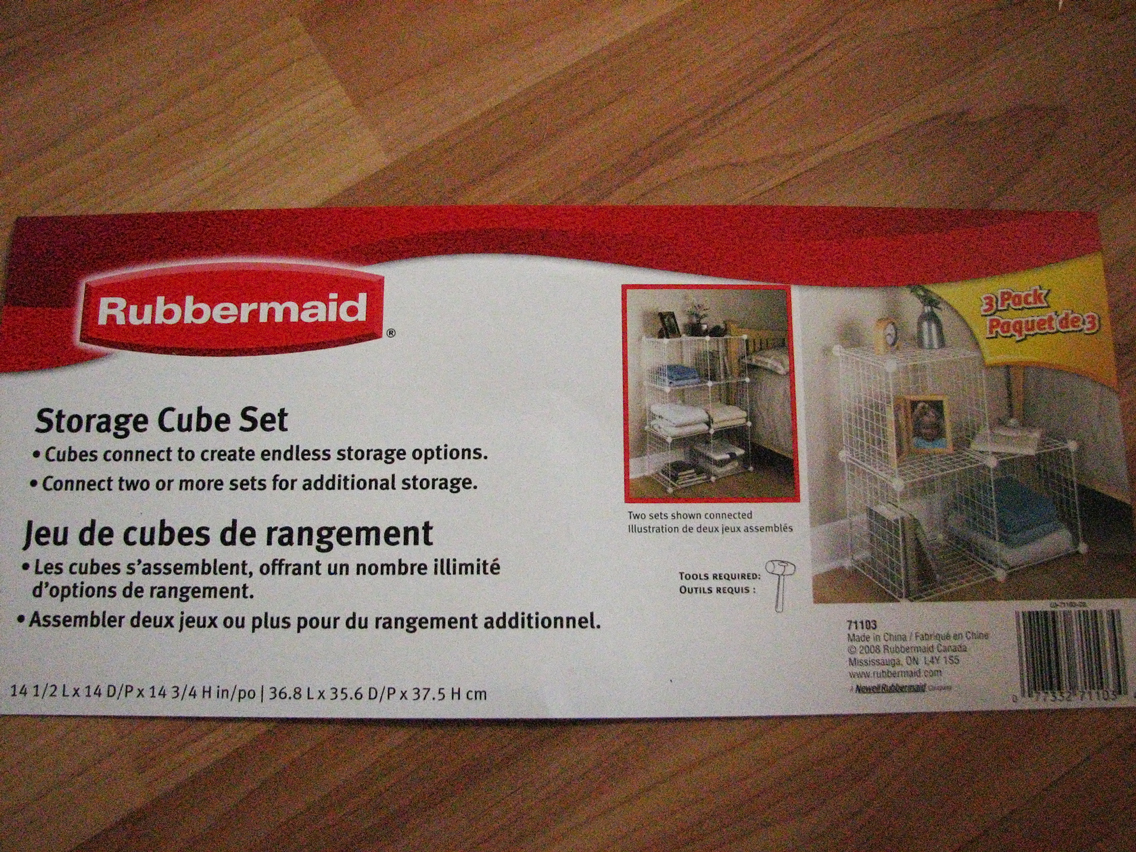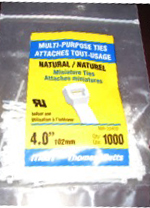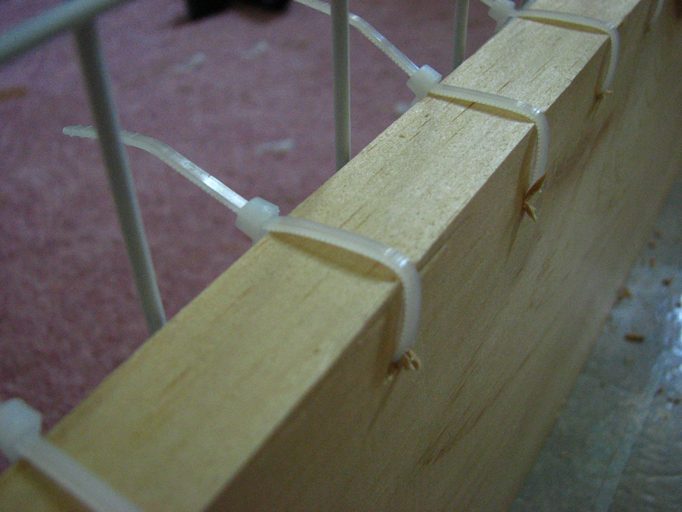Before reading this, please refer to my previous blog which provides reasons why building your own rabbit home is the way to go. There is also a link to our video to give you a visual of how we built our condos!
That being said, step by step how-to’s always come in handy!
Supplies
- Storage Cubes
 Your rabbit condos are going to be constructed out of storage cubes. These are 14″x14″ wire cubes that come in flat grids to be assembled for storage. However, partnered with zip ties, you can build pretty much any structure you’d like!
Your rabbit condos are going to be constructed out of storage cubes. These are 14″x14″ wire cubes that come in flat grids to be assembled for storage. However, partnered with zip ties, you can build pretty much any structure you’d like!
One of the great things about these cubes is that they aren’t overly big so you can just use less or more cubes depending on the space you’re building your condo for and the size of rabbit you have!
We found our storage cubes at Wal-Mart but also saw them at Space Age Solutions (where they were more expensive). If you’re in the States, apparently Target sells them too.
- Zip Ties
 Get the largest pack of zip ties you can find (We got ours at Lowes where 1000 zip ties was $9.99) because you’re going to need them!
Get the largest pack of zip ties you can find (We got ours at Lowes where 1000 zip ties was $9.99) because you’re going to need them!
Get the smaller zip ties. They will hold together better than the larger ones which tend to slip on the narrow storage cube grids.
- Wire Cutters
 Take it from us – scissors are not the answer! Your hand will be cramping in a matter of minutes! Instead invest in a pair of wire cutters. This will make cutting the extra off those zip ties easy peesy!
Take it from us – scissors are not the answer! Your hand will be cramping in a matter of minutes! Instead invest in a pair of wire cutters. This will make cutting the extra off those zip ties easy peesy!
- Wood for flooring, to act as a perimeter around your cage and ramps.
Any of those supplies are fairly inexpensive and you can find them at any building supplies stores. For the frame around the cage you’re going to want to spend a little extra and get all natural wood. It’s very rare that your rabbit won’t nibble on it here or there and anything chemically treated could kill your rabbit.
- Tile or Carpet to line your floors
This one is really just a preference. Some people like carpet because it’s warmer and adds traction for their rabbits to hop and play on. We at BudgetBunny went with tile because it’s easy to clean and our rabbits are not the best at using their litter boxes. Our rabbits also love to dig and rip and we didn’t want them ingesting any of the fibres. Plus, they’re in the warmest room in our house (don’t worry it’s not hot or anything, just gets a lot of midday sun) so the tile is nice and cool for them to stretch out on.
If you’re going with tile any will do! We picked the least expensive peel and stick tile they had to keep our cost low but if you want to match your decor you might opt for something fancier.
- Drill & Any Necessary Screws and Hinges
Hopefully you or someone handy will have a drill for you to borrow because they don’t come cheap! You’ll want a drill to secure the wood you’re using for framing to the base floors.
- Any furnishings you’ll want to include such as a hay rack, litter box, toys etc.
Let’s Get Building!
Start by measuring the space you plan to put your rabbit condo in. You’ll need to worry about the length, depth and height to build your cage. Remember to think about access to your rabbit and cleaning if you are looking to build your cage taller instead of longer or wider. Since the grids are 14” across when I broke down mine I thought in terms of how many grids I could fit in to my allocated space. The largest cage I could fit was 4 grids tall by 4 grids long by 2 grids deep.
BudgetBunny Savings Tip! Get creative with supplies you might already have in your house! We already had an ex-pen which are really pricey! It was only a few years old so instead of constructing our second cage from scratch we used a mixture of both the ex-pen and the storage cubes to build the condo that we wanted.
 Once you’ve determined your dimensions it’s time to get building! Start by lining up your storage cubes beside one another and use the zip ties to attach them to one another. I wanted to make sure my rabbit condos were secure and safe for my rabbits so I put a zip tie around every other grid. It’s also peace of mind knowing that if some snap you’ve got plenty more to support the cage.
Once you’ve determined your dimensions it’s time to get building! Start by lining up your storage cubes beside one another and use the zip ties to attach them to one another. I wanted to make sure my rabbit condos were secure and safe for my rabbits so I put a zip tie around every other grid. It’s also peace of mind knowing that if some snap you’ve got plenty more to support the cage.
BudgetBunny Tip! I don’t recommend using those little white knobs that come with the cubes to connect your cage together. Even with zip ties for extra support, they cause too much of a gap between the corners. Your rabbit could easily get her head stuck in there, or a paw or chew off the looser zip ties….it’s just not safe! And trust me if there’s a will there’s a way!
 Around corners I diagonally zip tied the cubes together to give them extra support. Cut any loose ends off with the wire cutters, leaving just enough that you’re able to grip the tie if you need to tighten them later on.
Around corners I diagonally zip tied the cubes together to give them extra support. Cut any loose ends off with the wire cutters, leaving just enough that you’re able to grip the tie if you need to tighten them later on.
This will be tedious, so I spent a few nights attaching the grids while watching my favourite television shows! Plus it makes it a lot easier for the rest of the construction if you have the perimeter already completed. You may be worried at first because the grids seem floppy, but once you start zip tying them together you’ll quickly notice how sturdy your cage becomes.
Next you’ll need to cut the wood for the floors. We used plywood for our flooring. You’ll be cutting the wood to fit inside the perimeter of the cage. Once you have your wood cut, you can begin laying the tile or carpet. If you choose tile I would also suggest using some hot glue on each corner. It will adhere that much better to the wood and if your rabbit decides to go on a digging rampage it’s less likely she’ll be able to lift one up. It’s also a good idea to put your tiles to the edge of the flooring, even though you’ll be attaching a frame on top. That way there are even less edges for your rabbit to try digging at.
 After you’ve finished the flooring, you’ll need to cut wood for the frame. You’ll want the frame to be at least a few inches high so it acts like a barrier to keep whatever your rabbit is kicking and flinging around inside the cage well, inside the cage! We flipped the floor that we’d just tiled upside down, and drilled a hole through the wood and floor, then used a long screw to attach them together. At this point, because of gravity, you may want to use clamps to prevent the tiles from lifting.
After you’ve finished the flooring, you’ll need to cut wood for the frame. You’ll want the frame to be at least a few inches high so it acts like a barrier to keep whatever your rabbit is kicking and flinging around inside the cage well, inside the cage! We flipped the floor that we’d just tiled upside down, and drilled a hole through the wood and floor, then used a long screw to attach them together. At this point, because of gravity, you may want to use clamps to prevent the tiles from lifting.
 Once we had the main floor completed, we wrapped the perimeter of the cage around it. The first thing we noticed was that the cage wasn’t sitting snugly against the floor. To keep everything as easy to clean as possible and to also prevent an injured rabbit, we drilled holes through the wood in between each grid, then used a zip tie to attach the wood to the grids. This forced the cage to stay nice and tight to the wood. Drilling and attaching zip ties to every grid may seem overzealous but between bunnies nibbling on the wood and us moving the cages around periodically, many have come loose.
Once we had the main floor completed, we wrapped the perimeter of the cage around it. The first thing we noticed was that the cage wasn’t sitting snugly against the floor. To keep everything as easy to clean as possible and to also prevent an injured rabbit, we drilled holes through the wood in between each grid, then used a zip tie to attach the wood to the grids. This forced the cage to stay nice and tight to the wood. Drilling and attaching zip ties to every grid may seem overzealous but between bunnies nibbling on the wood and us moving the cages around periodically, many have come loose.
 If you’re building a multi-level condo, you can repeat these steps for additional floors. Create a base for the floor to go on out of storage cubes, set your tile covered base on the cubes and secure to the cage using cable ties. Don’t be stingy on the cable ties here! An entire level of wood is going to be sitting on this so make sure it’s safe for Buns! You may also want to use a piece of doweling directly underneath a few parts of these additional floors to add extra support.
If you’re building a multi-level condo, you can repeat these steps for additional floors. Create a base for the floor to go on out of storage cubes, set your tile covered base on the cubes and secure to the cage using cable ties. Don’t be stingy on the cable ties here! An entire level of wood is going to be sitting on this so make sure it’s safe for Buns! You may also want to use a piece of doweling directly underneath a few parts of these additional floors to add extra support.
 When building ramps you’ll need to use a sturdy piece of wood so it doesn’t bend under your rabbits weight. Large hinges to attach the ramp to the floor will also ensure the ramp doesn’t break. You may also want to build small steps (we cut small pieces of wood and nailed them to the ramp) to aid your rabbit in climbing the ramp. We also ran a small but sturdy strip of wood up the center back of the ramp to add extra support.
When building ramps you’ll need to use a sturdy piece of wood so it doesn’t bend under your rabbits weight. Large hinges to attach the ramp to the floor will also ensure the ramp doesn’t break. You may also want to build small steps (we cut small pieces of wood and nailed them to the ramp) to aid your rabbit in climbing the ramp. We also ran a small but sturdy strip of wood up the center back of the ramp to add extra support.
Now it’s time for the fun part! Decorating! Fill your rabbit’s new home with lots of hay, food and toys and don’t forget, even though she has a sweet new pad to enjoy, she still needs at least 4 hours of free run time a day to keep her healthy and happy!



Pingback: Cage Size - The Good, The Bad & The Ugly - BudgetBunny
Pingback: Is A Rabbit The Right Pet For You? - BudgetBunny
Pingback: FAQ Friday: Your Advice Questions Answered! - BudgetBunny
Pingback: Housing – Develops your Dog’s “Hidden Intelligence”